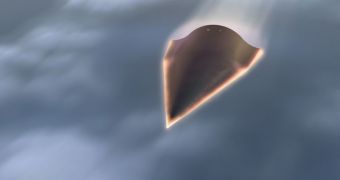On August 11, engineers and scientists with the US Air Force and the US Defense Advanced Research Projects Agency (DARPA) tested a hypersonic aircraft that was supposed to break all speed records. Though the test failed, the aircraft apparently managed to reach a top speed of Mach 20.
That is the equivalent of 20 times the speed of sound, which translates into roughly 13,000 miles per hour. At such a speed, the Falcon vehicle would have covered the distance separating New York from Los Angeles in a little over 12 minutes.
When the Falcon Hypersonic Technology Vehicle 2 (HTV-2) was launched, it was first sent to low-Earth orbit (LEO) atop a rocket. Takeoff occurred from the Vandenberg Air Force Base (VAFB), in California, and went on flawlessly.
The delivery system released HTV-2 in orbit, from where the vehicle took on a steep descent path. During its reentry into Earth's atmosphere, temperatures on the HTV-2's surface reached nearly 3,500 degrees Fahrenheit.
Once it reached its cruise altitude, it ignited its scramjet engine, and started accelerating towards Mach 20. After achieving its target speed of Mach 20, it continued to fly for about 3 minutes.
After that time, mission controllers lost contact with the Falcon, but at first DARPA engineers were unsure as to whether the aircraft actually managed to fly using its scramjet. In-depth analysis of available telemetry demonstrated that this was indeed the case, Space reports.
“HTV-2 demonstrated stable, aerodynamically controlled Mach 20 hypersonic flight for approximately three minutes. We do not yet know the cause of the anomaly for Flight 2,” DARPA director Regina Dugan said in a statement issued on August 14.
The reason why the USAF and DARPA are so interested in this difficult-to-control technology is that the Falcon is just a small part of a larger agenda. The Conventional Prompt Global Strike is an advanced weapons program that is meant to provide the United States with unrivaled capabilities.
If the technology tested on the HTV-2 matures, then the US will be able to deliver conventional or nuclear strikes to any target in the world in less than an hour. In all likelihood, the scramjet-powered bombers would be unmanned.
However, the Pentagon still has a long way to go before it can boast control over such capabilities. Both test flights of HTV aircraft ended prematurely, with the vehicles engaging a self-destruct mechanism that slams them into the ocean.

 14 DAY TRIAL //
14 DAY TRIAL //